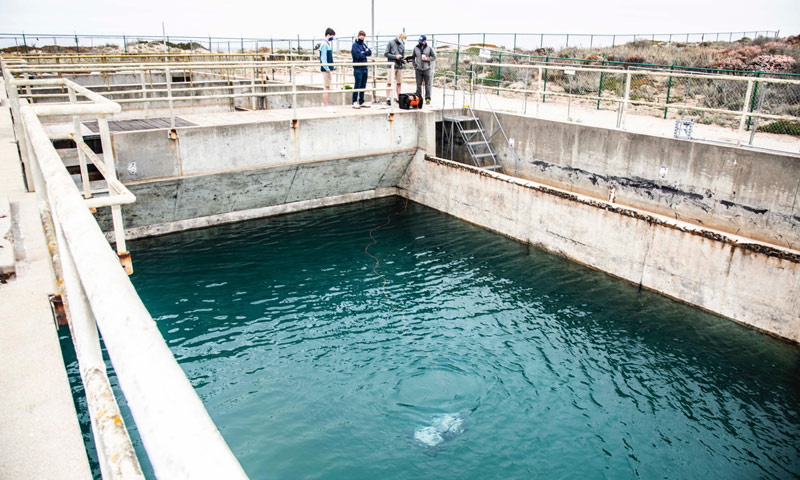MONTEREY, Calif. (NPS) – Once a county wastewater treatment plant, the Naval Postgraduate School (NPS) is creatively redesigning the site into a novel defense technology lab. Called the Sea Land Air Military Research (SLAMR) lab, it uses the existing infrastructure, such as multiple 450,000 gallon water tanks that have been recently cleaned and renovated, as an affordable and sustainable location for research projects focusing on national defense applications in robotics, autonomous systems, cybersecurity and maritime related 5G telecommunications.
SLAMR projects at NPS will address the rising sophistication of our nation’s potential adversaries. As other nations seek to diminish U.S. military superiority, the SLAMR lab – just across the street from NPS’ main campus – gives the university a physical environment to accelerate and deliver new defense applications through collaborative research, rapid prototyping and experimentation for the express purpose of accelerating the U.S. Navy’s advantage at sea. With ongoing support from the NPS Foundation, the SLAMR laboratory enables research and experiments with emerging technologies in water, on land, in the air and in cyberspace simultaneously.
"The SLAMR lab is intended to allow us to simultaneously engage terrestrial systems, subterranean systems, aerial systems, surface systems and subsurface systems in one," said SLAMR Director Dr. Raymond Buettner, NPS Associate Professor of Information Sciences. “It also allows NPS and its partners in government, academia and in private industry to collaborate more rapidly to identify new national security applications of dual use emerging technologies. For example, we have already hosted academic and industry partners conducting experiments connecting aquatic and ground systems simultaneously, and have enabled connecting systems here at NPS to others operated by academic researchers in Hawaii, and to systems operated by industry researchers in Massachusetts.”
“SLAMR is creating an environment for multiple stakeholders from across all sectors of defense, industry and academia providing an all-domain lab, which makes the research more accessible, sustainable and affordable for all,” continued Buettner.
According to NPS Dean of Research Dr. Jeff Paduan, an interdisciplinary lab like SLAMR will enable NPS faculty and students to create innovative defense solutions.
“This once dormant, aging, wastewater treatment facility built in the 1950s is now a critical piece of our education and research portfolio,” said Paduan. “The SLAMR lab will do as its name implies, and allow our faculty and students to deliver solutions on unmanned vehicles across the sea, air and land, and develop communications between those vehicles as well as the needed cybersecurity required for these next generation systems. I expect breakthrough technological solutions to come via SLAMR, which will not only enhance our educational experience for our students, but will develop those students into technology leaders that know how to employ those solutions.”
The SLAMR lab site will see moderate day-to-day activity with a handful of researchers on site, and with its water-based capabilities, it will also be a key venue for NPS’ quarterly Joint Interagency Field Experimentation (JIFX) event that hosts research collaborators from around the country. NPS has already used the site for a JIFX event in August 2021, hosting a dozen researchers, testing simultaneous control of ground and water-based vehicles among other technologies. The location also provides a great site for youth STEM activities and the SLAMR lab has already hosted a regional high school underwater robotics competition.
In July 2020, NPS and AT&T entered into a research agreement to explore innovative 5G network concepts that could one day connect ships, unmanned systems and sensors at sea. As part of that agreement, the SLAMR site is expected to become 5G capable via a temporary, short-range 5G antenna installed on site October 2021. The antenna will be oriented toward SLAMR’s water tanks dedicated to education and research.
“While NPS will be one of a dozen or so military installations working with 5G, those others are primarily focused on single use applications, like smart warehousing,” said Buettner. “At NPS, we will be looking broadly at a full spectrum of 5G applications for potential Navy-wide adoption.”
Buettner added that if approved, there are future plans to renovate other tanks on site to be dry tanks for ground-based vehicle experiments, and plans for an eventual design to allow for limited flight experimentation at the SLAMR lab.
Media are invited to contact NPS and visit the SLAMR lab. If interested in writing about SLAMR, contact Lt. Cmdr. Michael Larson, NPS’ Public Affairs Officer at michael.l.larson@nps.edu. For more information about SLAMR, visit: https://nps.edu/web/slamr


